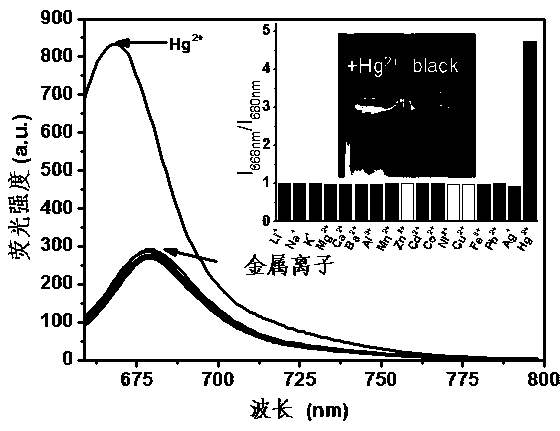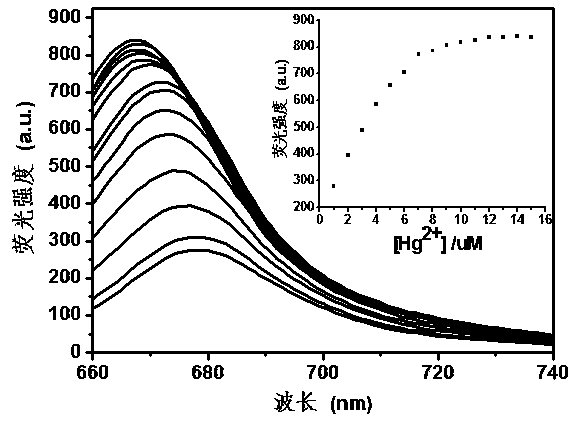A monothiosquaric acid dye fluorescent probe for detecting mercury ions and its preparation
A monothiosquarate, fluorescent probe technology, applied in the direction of azo dyes, organic dyes, fluorescence/phosphorescence, etc., to achieve the effect of specific detection
- Summary
- Abstract
- Description
- Claims
- Application Information
AI Technical Summary
Problems solved by technology
Method used
Image
Examples
Embodiment 1
[0032] The single sulfur sulfur acid dye formula (where R =-(CH 2 Cure n -CH 3 , n = 3) Preparation
[0033] Add 1,3-two- [4- (n, n-di-borne amino group) -2-hydroxybenzyl group in 100 mL three-port bottle], Lawson reagent (233 mg, 0.58 mmol), and 35 ml no water toluene, heating back 4 h under nitrogen protection.Removal distillation removes solvent, silicon column layer is pure, and the elimation agent is petroleum ether: ethyl acetate (20: 1, v / v).C.Ftir (kbr): ν max 2955, 1682, 1614, 1397, 1345, 1285, 1216, 1186, 1109, 910, 889, 802, 773, 718 cm -1 ;; 1 H nmr (400 mHz, CDCL 3 ): Δ 0.97 (T, J = 7.3 Hz, 12H), 1.37 (DQ, DQ, J = 14.7, 7.4 Hz, 8H), 1.70-1.58 (m, 8H), 3.44-3.32 (m, 8H), 6.10 (DD, J = 4.1, 2.4 Hz, 2H), 6.41-6.28 (m, 2H), 8.17 (D, J = 9.3 Hz, 0.6h), 8.94 (D, J = 9.4 Hz, 0.6h), 9.22 (D, J = 9.3 Hz, 0.8H), 11.07 (s, 0.8h), 11.68 (s, 0.6h), 11.76 (s, 0.6h); 13 C nmr (100 MHz, CDCL 3 , 177.22, 179.46, 185.04, 185.49, 197.03, 201.98; ESI-MS: m / z 537.2 ([M+H] + ).
Embodiment 2
[0035] The single sulfur sulfur acid dye formula (where R =-(CH 2 Cure n -CH 3 , N = 1) Preparation
[0036] Add 1,3-2- [4- (n, n-diolinel) -2-hydroxybenzyl groups] -2,4-cyclonecitone (82 mg, 0.20 mmol) to the 50 mL three-bottle bottle.Lawson reagent (162 mg, 0.40 mmol), and 30 ml no water toluene, in N 2 Heating back is 1.5 h under protection.The TLC tracking reaction raw material point disappears, decompression distillation removes solvents, and then washed the residue with petroleum ether to remove soluble impurities. The silicone column layer is pure. The eluent is petroleum ether: ethyl acetate (10: 1, v / v), Green solids are about 56 mg, the yield is about 66%, and the melting point is 260-262 ° C.FTIR (KBR): νMax 2955, 2931, 1679, 1601, 1387, 1333, 1272, 1238, 1210, 1142, 1074, 1009, 959, 805, 779, 713 CM -1 It 1 H nmr (400 mHz, CDCL 3 ): Δ 1.28 (t, j = 7.1 Hz, 12H), 3.51 (q, j = 7.1 Hz, 8H), 6.16 (s, 2H), 6.46-6.34 (m, 2H), 8.22 (d, j = 11.55.5Hz, 0.6h), 8.99 (d, j = 7.3 Hz...
Embodiment 3
[0038] Founded dyes have strong absorption and efficient fluorescent launch in near infrared, making it widely used, as a superior prescription dye probe (where R =-(CH CH 2 Cure n -CH 3 N = 3) The specific recognition of mercury ions based on chemical reactions makes it a good mercury ion probe. figure 1 and figure 2 A prescription dye probe is given respectively (where R =-(CH 2 Cure n -CH 3, N = 3) Ethanol / hepes (70:30, V / V) buffer system with 7.2 response to different metal ions in the cushion system, the existence of mercury ions will cause obvious absorption spectrum and fluorescence spectrum displacement.Realize the detection of mercury ions.Based on the qualitative testing of mercury ions, the quantitative test of mercury ion is achieved.Experiments give me mercury drops of fluorescent changes image 3 It can be seen from the ticking curve that the detection of mercury ions in the range of 0-6 is good linear, and spectral experiment data proves that the dye probe is gener...
PUM
 Login to View More
Login to View More Abstract
Description
Claims
Application Information
 Login to View More
Login to View More - R&D
- Intellectual Property
- Life Sciences
- Materials
- Tech Scout
- Unparalleled Data Quality
- Higher Quality Content
- 60% Fewer Hallucinations
Browse by: Latest US Patents, China's latest patents, Technical Efficacy Thesaurus, Application Domain, Technology Topic, Popular Technical Reports.
© 2025 PatSnap. All rights reserved.Legal|Privacy policy|Modern Slavery Act Transparency Statement|Sitemap|About US| Contact US: help@patsnap.com



